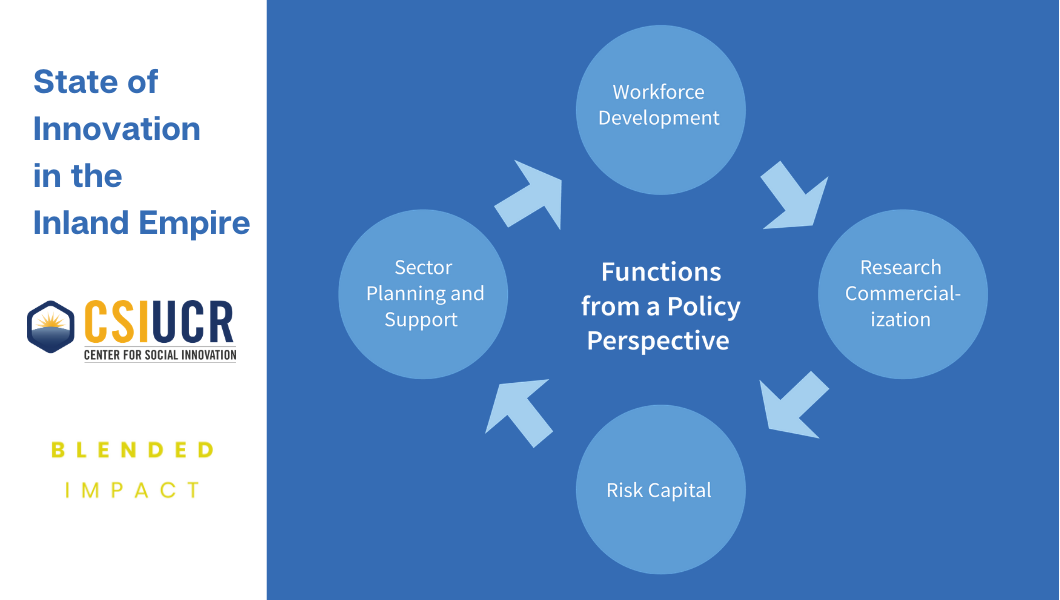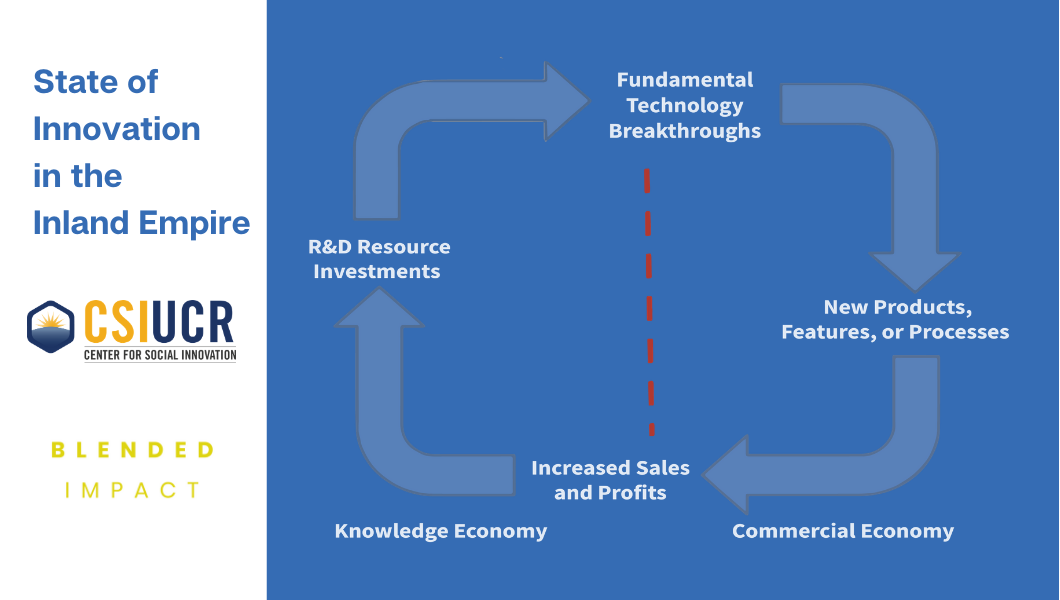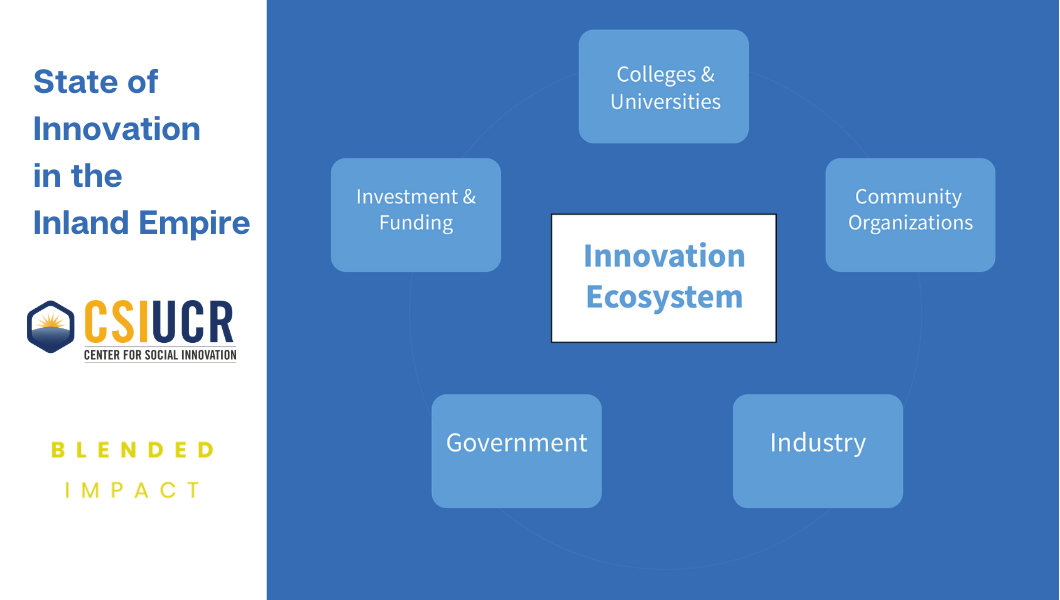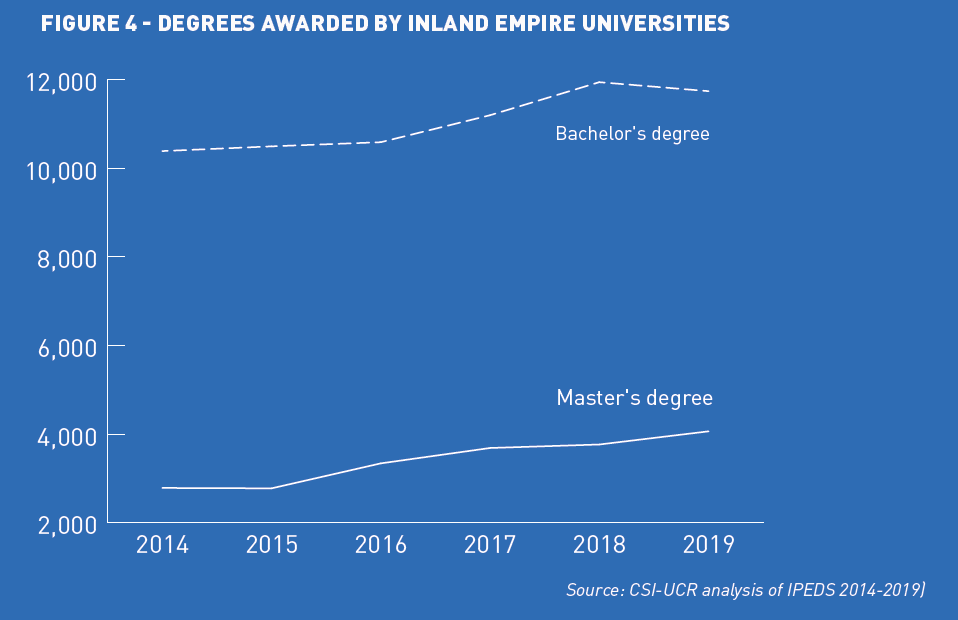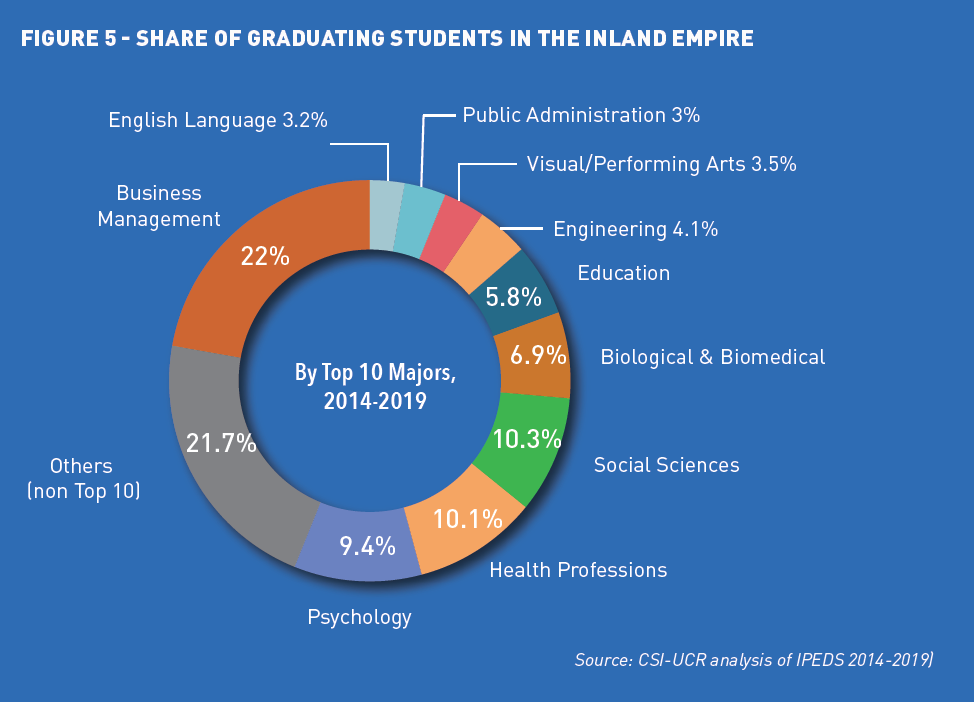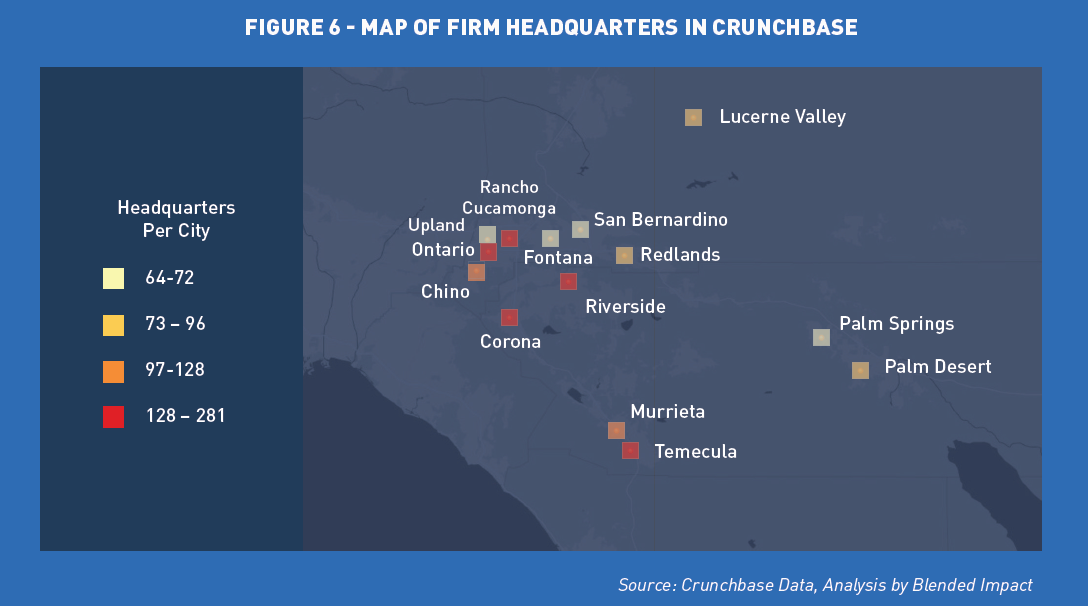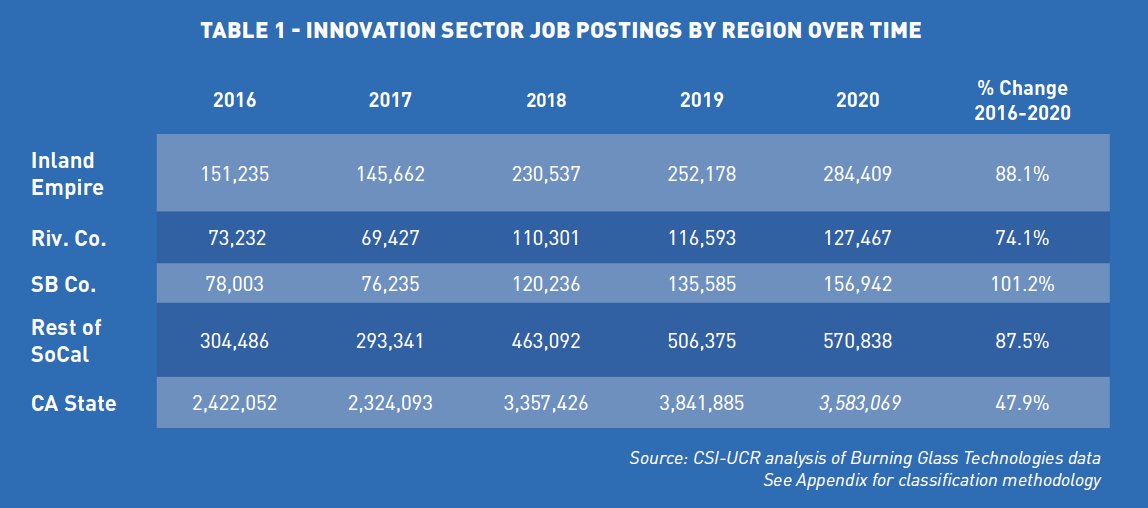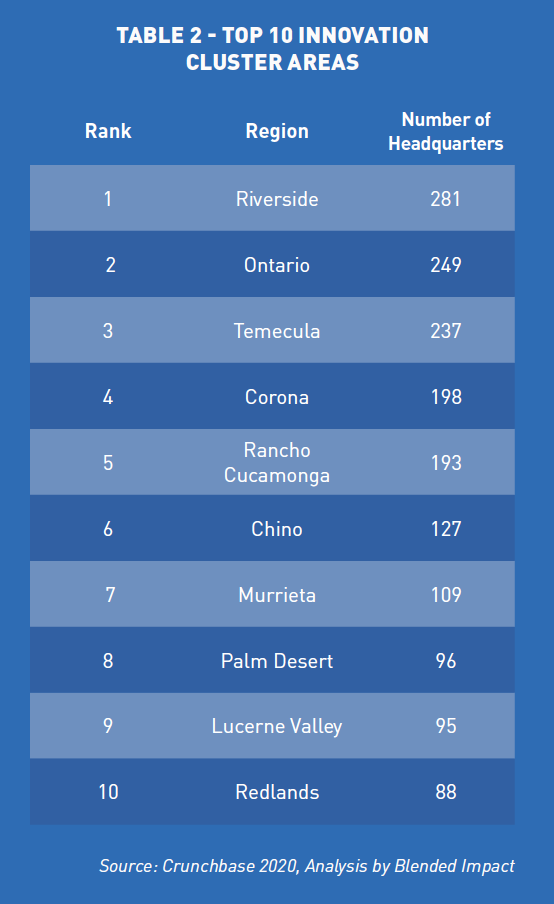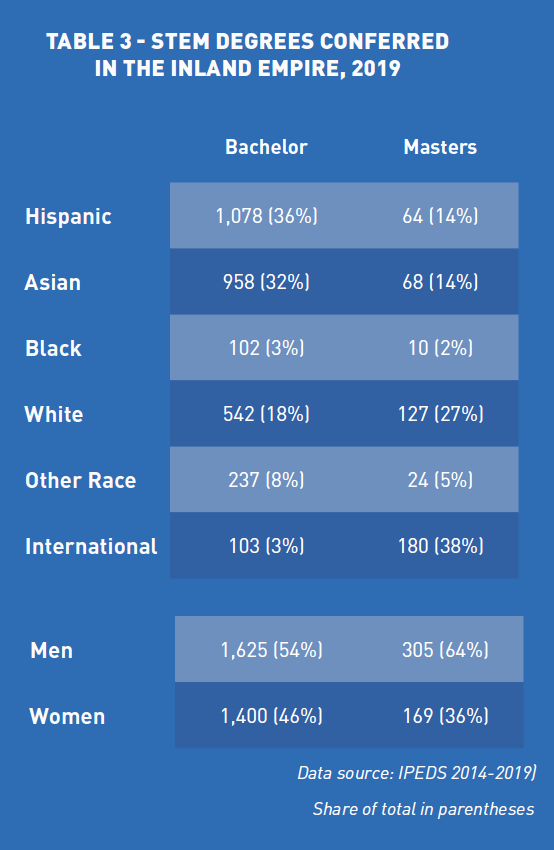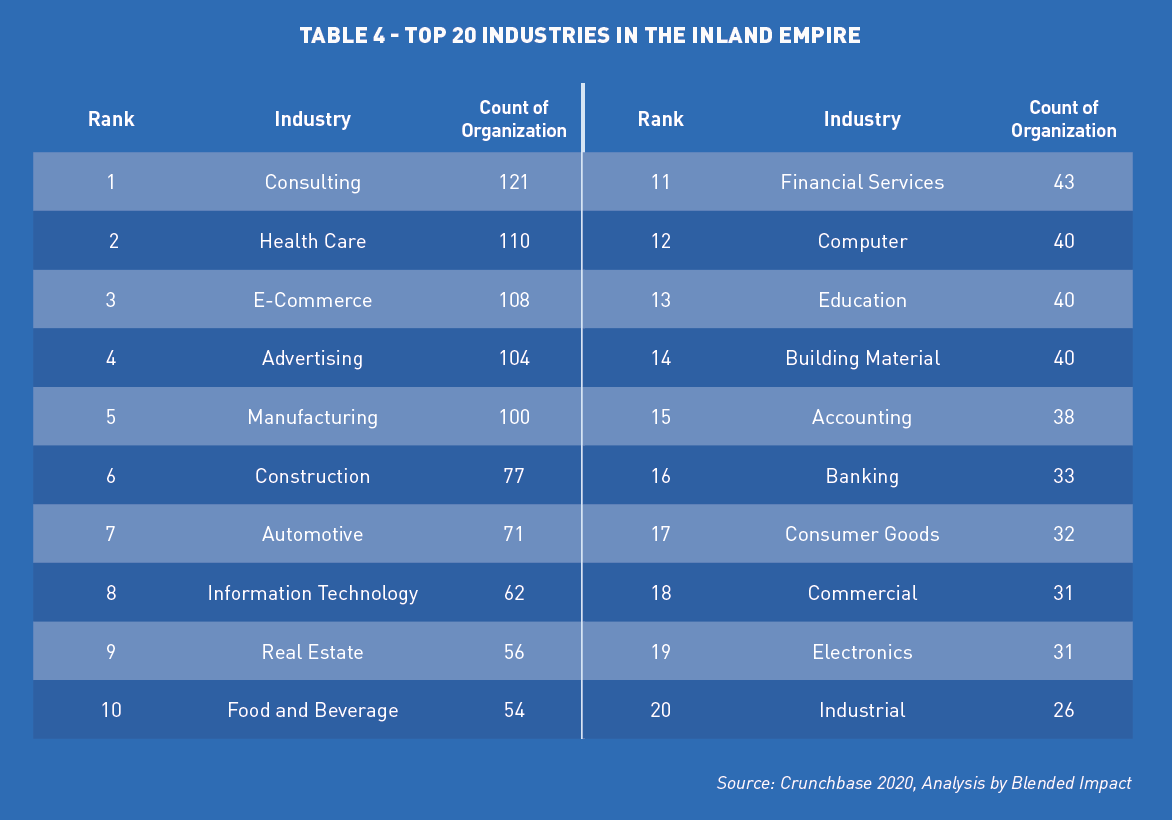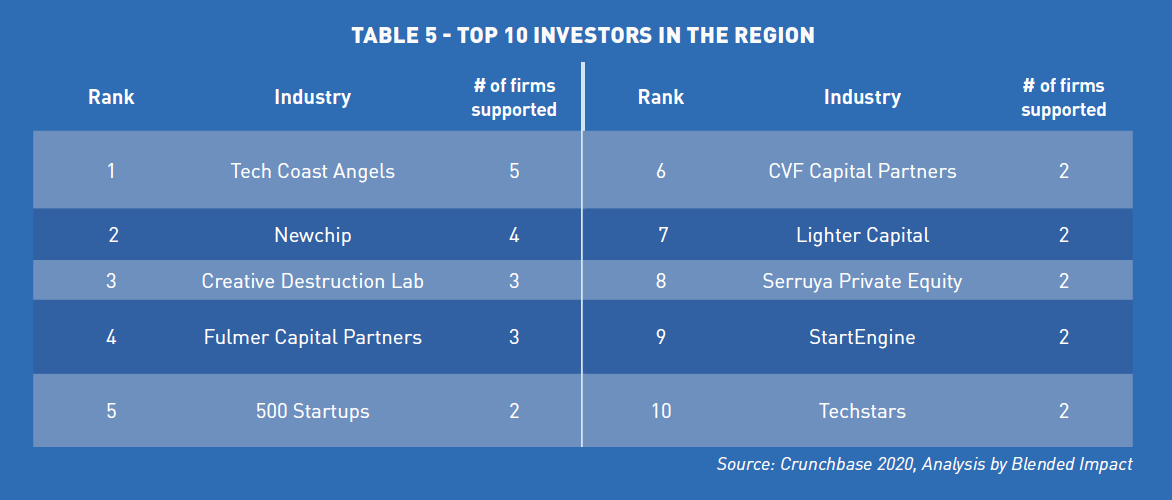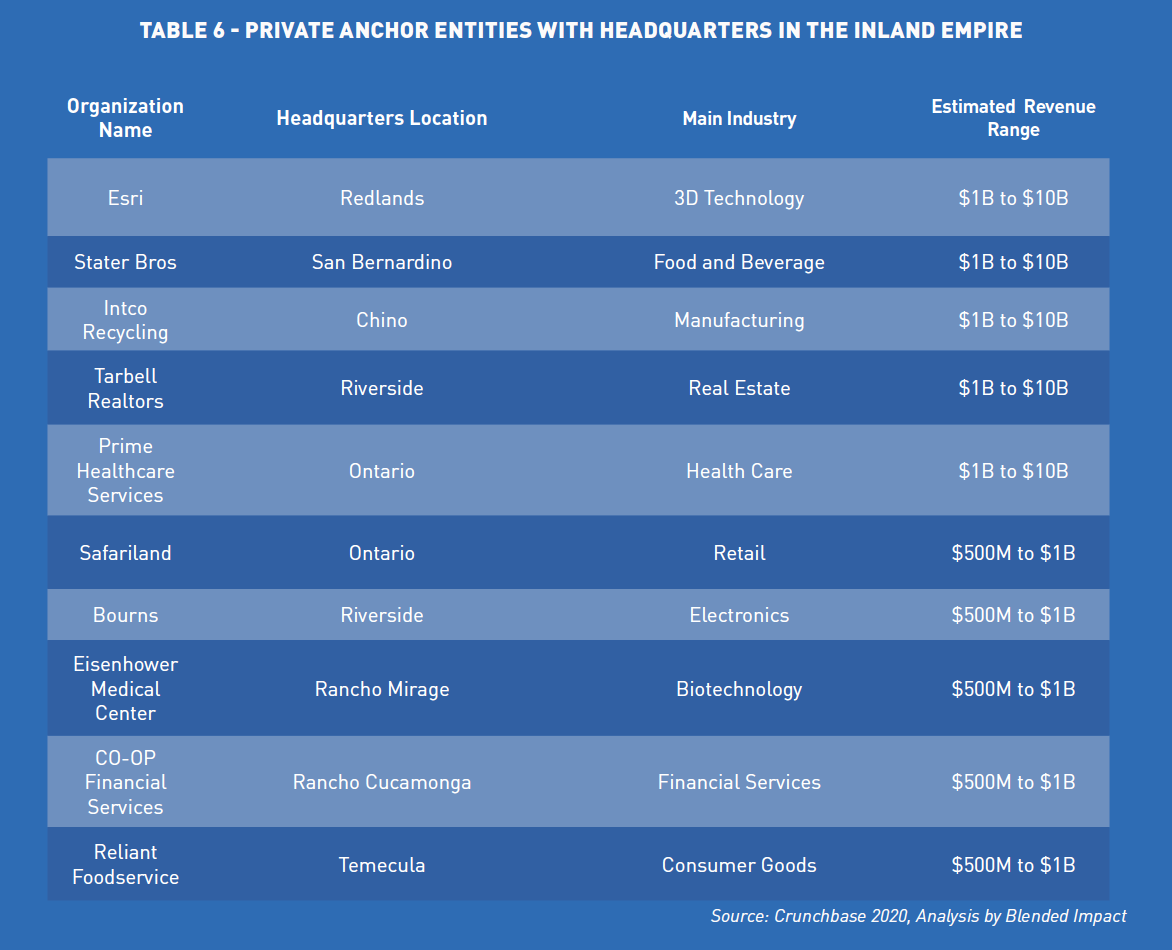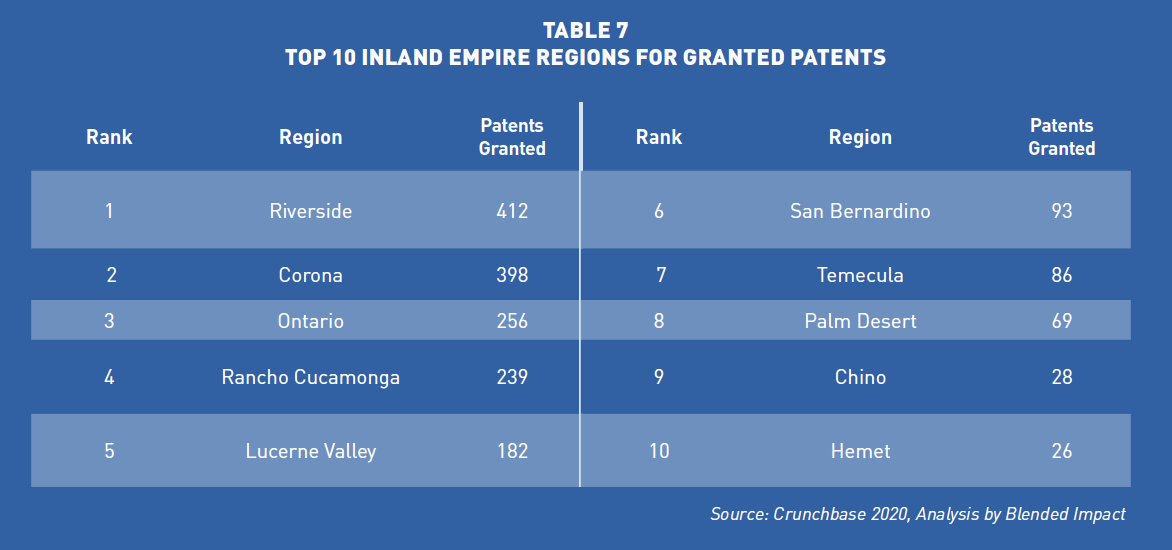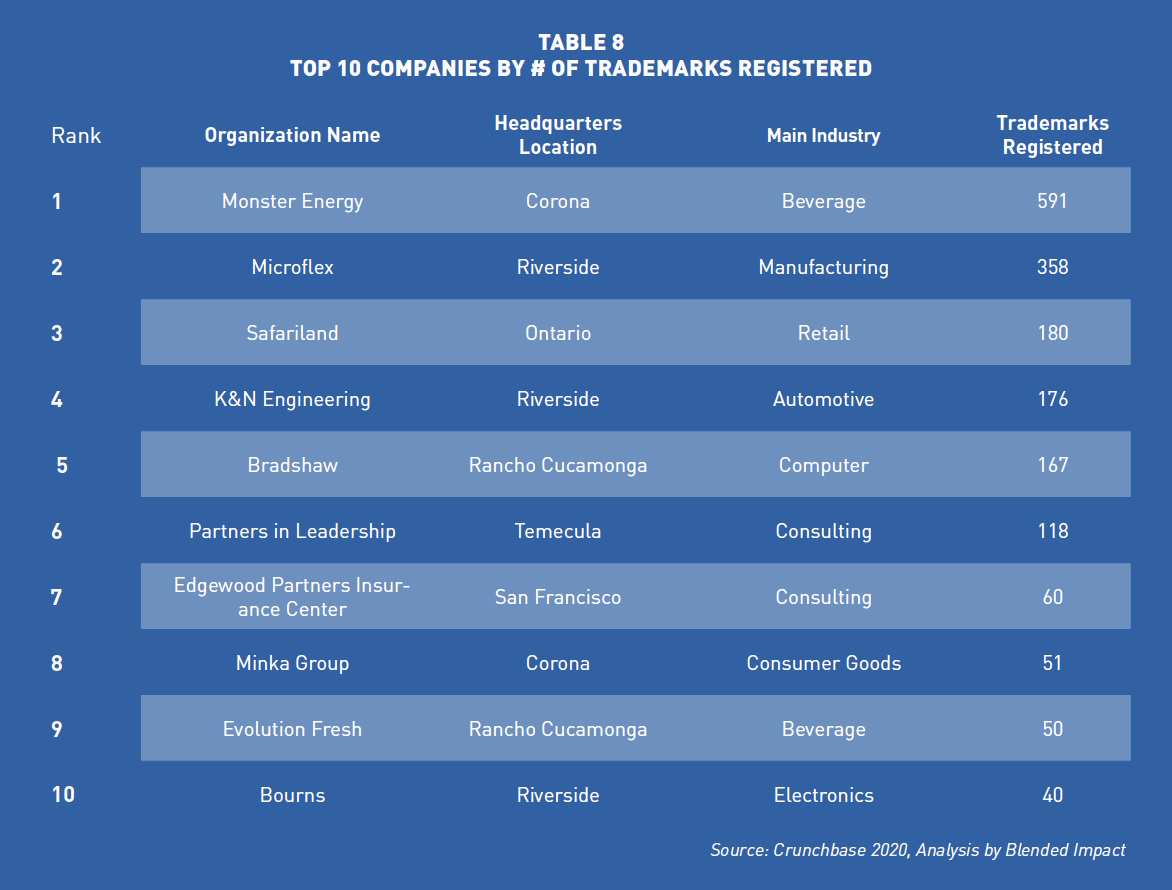Center for Social Innovation
State of Innovation in the Inland Empire
The innovation economy in the Inland Empire—whether measured by startup formation, acquisitions, investments, jobs, research and development activities—have grown significantly in the last decade, and offer great promise for the thousands of bachelor’s and master’s degree graduates who graduate each year from the region.
This report provides an overview of the innovation eco-system in the Inland Empire, offering an opportunity for investors and stakeholders alike to better understand the landscape of assets, relationships, and activities that are diversifying the region’s economy and enabling it to grow more high-skilled jobs.
The report touches on relevant research in the field and offers several models for understanding the concept of an innovation ecosystem and how it functions. Additionally, we catalogue the most significant innovation sectors in the region, including those with long histories and those of more recent vintage.
Importantly, the Inland Empire is home to a rapidly growing skilled workforce. According to job posting data, jobs in the innovation sector have grown by 88% since 2016, a rate comparable to the rest of Southern California. The IE’s skilled workforce is also racially diverse, with Latinx students accounting for 33 percent of STEM graduates with bachelor’s or master’s degrees in 2019, and Asian American and Black students accounting for 29 percent and 3 percent, respectively. Still, more progress needs to be made, particularly with respect to the racial diversity of students with master’s degrees in STEM and non-STEM fields.
Our industry and sector analysis shows that there are several active and thriving innovation clusters in the Inland Empire, including in consulting, health care, and e-commerce, with emerging strengths in biotech, clean energy, and clean transportation. Our survey and interview data also indicate a strong willingness to collaborate among various innovation-sector leaders in the region. Importantly, firms, investors, and policy leaders are also growing their connections to related hubs in Los Angeles, Orange County, and San Diego.
Given the emergent strength of these Inland Empire clusters, it will important for economic and policy decision-makers to seize the moment and 1) invest in ecosystem builders who can bolster the region’s ability to drive deeper collaborations, 2) shape a stronger narrative for internal and external audiences, and 3) strengthen emergent relationships and partnerships that connect the Inland Empire with the rest of Southern California.
Community Profiles
-
Alliance SoCal
Representative: Eric Eide
Position: Director of Ecosystem Development
The Alliance for Southern California Innovation (the “Alliance”) brings together Southern California’s top research institutions, local business leaders, and world-class advisors to focus on bridging critical gaps in the SoCal innovation ecosystem. The goal of the Alliance is to engage and unify SoCal’s compelling diversity of talent, ideas, and perspectives in order to optimize the conditions for the region’s innovators to bring breakthroughs to the world.
Key components of an innovative ecosystem include mobilizing a broad group of stakeholders that can support entrepreneurship and innovation. Eric describes an ideal coalition of universities, city governments, advocacy groups, business leaders and corporations. “Those are the core groups that we think are foundational to having a vibrant ecosystem,” explains Eric, “We also need to collaborate and be connected. We need to have the pieces, they need to talk to each other, they need to be aligned, and work together on activities that deliver impact.”
Eric describes the confluence of capital, ideas, and infrastructure that are needed in order for true innovation to take place. These include human capital, risk capital, IP generation, corporate partners, and, often ignored in the discussion, the culture element that includes a risk-taking mentality and people willing to pursue new ideas. “All of these integrated elements are what create an ignition for an innovation ecosystem,” explains Eric. As he explains, “Capital follows opportunity; it looks where innovation is happening”.
As a historically marginalized region, a continuing challenge includes a lack of awareness about the capabilities and opportunities that exist in the region. Eric notes that it is important to highlight those capabilities and to hold up examples to inspire people locally, to provide a roadmap and the tools to help local leaders support and develop their community’s innovation potential. “Having resources, infrastructure, and being authentic about the region’s core competencies all important for raising the region’s stature.” As for opportunities for strengthening the innovation sector in the Inland Empire, Eric notes the importance of partnerships and collaboration, as well as defining the center of gravity in the region.
-
Bitwise Industries
Representative: Beth Mily
Position: President
Bitwise Industries employs an ecosystem approach to give marginalized communities opportunities in the tech industry using a multi-pronged strategy. They provide coding training for youth and adults, aimed at creating a diverse, inclusive talent pipeline, where anyone is able to learn and then utilize their skills immediately in the tech industry. Beyond training, Bitwise Industries also buys properties in downtowns, rehabs them, and leases them to tech industry companies. In addition to providing workspace, they are also involved in tech colusting to support and serve these companies. These pieces work together to encourage regional economic growth and help marginalized communities with access to high-growth, high-paying jobs. The three components in the Bitwise model set them apart from other companies, because they work to create an entire innovative ecosystem for the communities they work with.
Bitwise President Beth Mily describes the impact on the region as encompassing both economic growth as well as cultural and community growth. In addition to the high numbers of jobs being created each day, Bitwise is also at the forefront of building a community of businesses and residents in the downtown Fresno area by hosting community-based events and providing a pipeline for training and jobs in the tech industry. Beth believes that providing technical and financial support to local creators is a key step in identifying and cultivating talent, a key piece in creating an innovative ecosystem. Bitwise partners with local institutions of higher education are also important to their work because of their connections with the students as well as their understanding of community needs. “We see the higher ed institutions as the “lecture” model, and ours is the hands-on “lab” model, but both are important,” says Beth.
A challenge that impedes innovation includes municipal roadblocks, but collaborating with other organizations doing innovative work is crucial in developing lasting partnerships to better the region. As Beth states, “A grassroots type of effort can create really innovative practices.” Marginalized communities also have many opportunities for growth, particularly where there exists a great deal of need for industries with social impact. Beth believes that growing opportunities for tech training and industries will create more opportunities for these regions to grow.
-
City of Murrieta
Representative: Scott Agajanian
Position: Deputy Director of Economic Development
Murrieta, located in South Riverside County, is one of the newest and most innovative communities in the region. With a populace that has a higher than average number of residents with bachelor’s degrees, the city chose healthcare as a field that they wanted to focus on. “Economic development started getting more innovative, including more emphasis on workforce development, innovation, and entrepreneurship. This is how we are taking healthcare and moving beyond being a healthcare service provider. We are now getting into biotech,” explains Scott. The city’s biotech incubator, the Murrieta Innovation Center, is now a biotech hub, bringing in patents, investment, and new industry. He views his role as Deputy Director of Economic Development as a facilitator between business, real estate, and city government.
A challenge includes a dearth of funding sources, particularly in terms of recognizing the intellectual property value in the region, “There is a severe lack of investment in ideas,” says Scott. The region is starting to change, with startups getting priced out of the Los Angeles and San Francisco markets and moving to the area because of the opportunities that are blossoming for innovation. Still, he believes, political will and a commitment to economic growth plays a crucial role in the quality of investments and startups.
A challenge that exists with building out the innovation ecosystem in the Inland Empire includes getting more cities across the region on board. As he says, “It takes more than just a few cities steering it. All cities want to have an innovation footprint, but it takes an investment from all of the cities in the region, in both counties.” He believes a stronger coalition will allow for more opportunities to showcase the innovation that is happening in the region. Scott also believes that the moment is ripe for even more growth over the next ten years, particularly as Riverside County becomes more separated from the coastal region because of population growth and commuting patterns, “This will cause the necessity of innovation and will speed up the business development process,” he describes. All cities have opportunities for support and the talent needed for more growth, but intentional cultivation is key to ensuring sustained growth in the IE.
-
City of Riverside
Representative: Nathan Freeman and Jon Marks
Position: Senior Development Manager; Project Coordinator
The City of Riverside’s Innovation District is years in the making and stems from the Mayor’s vision. It focuses on building a live, work, play model with support for small entrepreneurial startups that connects the UC Riverside area, downtown, and East Side neighborhoods. Nathan and Jon, describes the process which included a series of community engagement events with multiple stakeholders, including representatives from public, private, and educational sectors. The components of the innovation district are multi-pronged, including training to provide formal and informal pathways for people to be involved in the district, access to capital, mentorship, and public/private partnerships-all with the goal of creating a spectrum of investment opportunities. Nathan believes that a cohesive model that welcomes innovation will serve the entire city, and a critical piece of this work includes understanding community needs and ensuring buy-in from all stakeholders.
A challenge that can potentially impede innovation in the Inland Empire includes a lack of funding for innovative projects. A more streamlined process for adopting innovative projects and clearly identifying regional leaders and champions would also be beneficial. Finally, encouraging more community participation and working through challenges is an important component. Nathan and Jon remain optimistic about the opportunities to strengthen the innovation sector in the region, including programs that aid in building strong communities in the region, keeping Riverside a great place to live, and removing barriers to innovation and entrepreneurs.
-
Entrepreneurial Proof of Concept and Innovation Center (EPIC)
Representative: Scott Brovsky
Position: Associate Director of Regional Engagement and EPIC SBDC at the University of California Riverside.
EPIC works to validate and accelerate the transformation of ideas and inventions into products or services for the marketplace. They identify promising startups, provide mentors with different skill sets, work with students interested in entrepreneurship, and support incubators managed by UC Riverside. “We focus on growing companies that will stay in the region and create high paying jobs,” says Scott. EPIC also supports the Excite and Wetlab incubators, both connected to UC Riverside, as well as community startups. This work has been instrumental in growing the startup ecosystem in the region.
Scott believes that there are several components that are key in building the tech ecosystem in the Inland Empire. Having the support of research universities like UC Riverside and Loma Linda University provide a wealth of resources. Cultivating talent is also an important component, one that has often been a challenge in this region. “A company may start and get traction, but they leave because they can’t find the talent. We need to give students interested in entrepreneurship a reason to want to stay in the region,” says Scott. Access to capital has also been a challenge in the region, particularly because of the lack of angel investors that are crucial in helping to build tech companies. Until there are more investors in the region, there will be continued pressure for startups to leave, the only way to counteract that is to get funding and talent from the IE.
Scott believes that the Inland Empire can position itself as a place of innovation by focusing on key verticals, such as ag tech, clean tech, biotech, and medical device tech. “We need to be known for a few things, we can’t be all things to all people,” explains Scott.
-
Esri
Representative: Brooks Patrick and Christine Ma
Position: Business Development Manager Smart Cities at Esri and Account Executive
Esri is a technological provider of the geographic information systems software web GIS and geodatabase management applications. The company is based in Redlands and aids both cities and businesses with general plan updates and data to improve city housing, transportation, and environmental structures. Esri was founded as the Environmental Systems Research Institute in 1969. Throughout recent years, Esri has grown significantly in terms of business development and production. They have 10 regional offices throughout the nation, and 80 international distributors, and are the foundational component of a tech-centered innovation cluster in the Redlands region.
Brooks and Christine are currently managing ArcGIS Urban, which facilitates urban planning through 3D-application, scenario planning, and impact assessment. Another project is ArcGIS Hub, which is a cloud of data intended to be shared and utilized for in depth planning and community assessment. Both ArcGIS Urban and Hub are centered around the workflow process necessary for an update policy. Whether its a warehouse or multi-story building, ESRI has the software that allows government approvals and local organizations to review proposals from these infrastructure more effectively. ArcGIS Urban specifically provides a 3D map to review hidden factors that surround the building and affect the proposal.
Brooks believes that affordability is working well in the Inland Empire. Major cities are struggling with housing challenges associated with not building enough residential units to keep up with their development. The city of Boston, for example, faced an exponential growth in population recently and now have to grow by nearly 100 projects a year. To keep up with the development, they had to add new housing goals increasing the amount of housing units and also ensuring they are affordable. Additionally, construction costs have also risen by about 60% within the last 20 years. Combing these two factors where most areas will have to grow more bearing in mind that its becoming more expensive to grow, the Inland Empire is in a roughly better position. The IE for a long time has not been densifying but has now gained the opportunity to do so. A lot of Esri’s interactions with cities in the IE go into the planning and policymaking for making the IE more developable and prepared for a denser population in the future. The IE is in a good spot right now in that it provides middle-class income housing opportunities that would not be available in parts of Los Angeles and also parts of Northern and Mid California. The IE also has the unique ability to promote affordability as well as a proximity with local developing areas like Orange County and LA County. A part of the reason Esri is where it is today in the IE is actually because of the specific positioning and affordability of the region.
In addition to housing, other components include the Transit Village Plan in Redlands and the light rail that allows the IE to be connected to the transit service in Los Angeles, offering more transportation services than just the automobile. With the Transit Village Plan, Redlands is also trying to grow in housing affordability and mixed use development where houses are local to grocery stores, transportation services, and other needed resources. Ontario and Riverside are also doing a general plan update and looking for areas of mixed use development and areas to grow in density. This is primarily a good type of density growth, not like NIMBY (not in my back yard) Density which typically reduces personal mobility.
-
Milken Institute
Representative: Matt Horton
Position: Director
The Milken Institute is a non-profit nonpartisan economic policy think tank divided into various centers and policy focus areas. Matt Horton is the Director for the Center for Regional Economics and California Center. Through this capacity, the Institute examines regional economic growth trends, workforce, infrastructure, housing, and resilience in terms of illustrating the inputs that are driving growth and knowledge-based growth from a sector standpoint. Additionally, Milken Institute has several programs currently focused more closely on the dynamics shaping the future of work. Of the following include the Best-Performing Cities index which tracks and measures city performance from a knowledge-based economic development measurement. Another is the state technology and science index which, every other year, gauges the investment being done on education and human capital at the state level. Milken is also engaging a series of conversations around the state about the future of work and what that looks like from an equity, digital access, and core competencies standpoint. Topics include developing collaboration partnership between employers and higher education leaders that addresses growing automation with reskilling and other related talent developments initiatives for an incumbent, displaced and prospective workforce. Through this lens, Milken examines how local, regional, and state leaders can leverage investments in infrastructure and talent that support equity while seeking to enhance access to jobs at different levels and sectors.
As Matt mentions, “It's hard to think about these investments in silos”. The Milken Institute aims to facilitate a broad economic mobility conversation that connects with policy, community stakeholders, and private sector leaders involved in shaping transportation, housing, and workforce development decisions., Through this work of the Institute, Matt believes that fundamentally, resilient economic growth is a byproduct of these coordinated investments in talent and infrastructure that leaders dedicate overtime. Additionally, by engaging at a local and regional level we can identify and scale bottom-up solutions to reflect diverse community needs.
Matt also believes that, from a statewide workforce and economic development perspective, one of the apparent challenges is in devising and sustaining the necessary governance and funding schemes that facilitates more comprehensive/ equitable opportunities. For example, by investing in research and development that is connected to higher education and local production is lacking element in terms of spreading the tech transfer and commercialization engine around the state. Renewable energy, advanced manufacturing, and agriculture, as well as biotechnology and the life sciences are vital industries and sectors that support well-paying jobs that colleges and communities can think about supporting in terms of furthering regional competitiveness. In terms of local government, Matt states that we need to not only think how we can attract these well-paying jobs, but how state and local leaders are facilitating business formation especially for small businesses and mom & pops shops as they together represent one of the state’s largest employers.
Lastly, in terms of prioritizing what investments are needed, Matt mentions that, from a human capital perspective, facilitating a skilled and robust talent development pipeline is important. Matt believes that from a regional competitiveness perspective, leaders should look to design a 21stcentury workforce model in response to an evolving job market. One that enable students a flexible platform to hone their development overtime while actively engaging employers in the education to employment pathways through targeted reskilling, work-based learning, and other apprentice and skills based learning programs.
-
San Bernardino County Transportation Authority (SBCTA)
Representative: Carrie Schindler
Position: Director of Transit & Rail Programs
The San Bernardino County Transportation Authority is the primary organization in charge of regional transportation planning, allocation of transportation funds, and construction of major transportation projects in San Bernardino County.
Currently, SBCTA is leading the Redlands Passenger Rail Project. This innovative project includes introducing tier 4 Diesel Multiple Units (DMUs) into the Metrolink system between Redlands and San Bernardino. These are smaller trains that can fit on the heavy tracks and run in the same areas as the heavier locomotives and even freight trains. Three of these units are expected to be operational by 2022. Further, SBCTA in partnership with CalSTA and Stadler Rail, is developing a hydrogen powered zero-emission multiple unit (ZEMU) based on the DMUs. Ultimately, the ZEMU will produce zero exhaust emissions of pollution through any methods of function. The ZEMU will be the first in the nation of its kind. The ZEMU will comply with FRA requirements to fit in heavy rail lines, making them easily transferable to existing rail systems throughout the region, and are now smaller, lighter, and more efficient than previous trains. After testing in Europe, the ZEMU will be delivered to the Inland Empire in late 2023.
Carrie mentions that there are numerous secondary benefits from the RedlandsPassenger Rail Project. The rail rides along the I-10 freeway, alleviating the congestion and traffic that usually occurs there. There is also a social benefit to being on the train with other members of the community and also having access to internet connection with a laptop or phone to work during your commute. The University of Redlands has a program for students to take part in internships focused on community service projects in Los Angeles. Many of the students don’t have access to personal vehicles, so they rely on the transit system. The University also has a partnership with Esri, and the rail system facilitates transportation and communication between the two campuses.
Carrie believes that public–private partnerships like Esri, the University of Redlands, and SBCTA are vital for the community as they provide each other with innovative technology, local support, and diverse inputs in necessary conversations. Additionally, with Esri and the rail project developing at such a rapid pace, Redlands as a sector has grown to attract employees in technology and promote even more growth and development within the area. Carrie mentions that she heard from Esri that their candidates have considered Esri largely because of the rail project and connection to the transit system. There are two enhanced transit connections to the OntarioInternational Airport under development now, and Esri brings a couple hundred people every week into Redlands through the airport. In terms of the pandemic, construction of the Redlands Passenger Rail Project has been able to progress on schedule, taking advantage of reduced traffic handling challenges due to less roadway travel by the public.
-
County of Riverside
Representative: Rob Moran
Position: Deputy Director at Riverside County Business and Community Services
Riverside County Business and Community Services (formerly known as the Riverside County Economic Development Agency) was established after a restructuring of the County’s economic development agency. They focus on economic development, business attraction, retention and small business assistance efforts. “Small business services are our lifeblood in this entire region. We need to ensure that we have the sufficient support and network ecosystem to support them,” says Director Rob Moran. Although the pandemic created unique challenges in the county, Rob noted some silver linings. In particular, the pivot to telecommuting and discovering that there is so much more that can be done with technology, even in non-tech sectors, to help them be more efficient and productive. Despite the flexibility that was demonstrated, many communities and populations did not have the same level of access to high-speed internet or online services. “We still have to go into communities, we can’t assume everyone will have Zoom or that we will reach everyone online,” says Moran.
Key components of an innovative ecosystem include entrepreneurship innovation that can come from diverse sectors, not only limited to those in high tech spaces. Incorporating entrepreneurship and financial literacy at the K-12 level will also help support the next generation of innovators. “It’s not just one entity,” says Moran, “it’s having an environment that encourages the exchange of ideas and transferring this information from one group to another. We need a support system to help folks engage.” Despite the vast geography of the region, there are high levels of collaboration. These partnerships have been partly facilitated by technology that helps bridge the gap between different organizations. The region’s increasing innovation ecosystem has also garnered attention from more established regions like Los Angeles and the Bay Area. Moran partly attributes this to the lower cost of living and business in the region, but more importantly, to the support system and activity that is happening in the region. The various incubators, the UC Riverside Bourn’s College of Engineering, UC Riverside’s Office of Technology and Partnerships, CSU San Bernardino’s innovative work, and the California Air Resource Board (CARB) project that are situated in the Inland Empire are all putting the region on the map.
Challenges in the region that impede innovation include the need for more mentorship from existing business leadership and strengthening the network of those who have previously been through the process. Additionally, having more investment capital, both internal and external are critical to building a strong ecosystem. Investors are looking for deal flow and scalable companies. Strengthening this infrastructure will help build up the region. Although the region is vast and diverse, building a strong entrepreneurial ecosystem is important to the region as a whole. “We need to provide greater access to programs and services, harness the intellectual capital that exists in Riverside County, and continue to grow it,” says Moran. Growing STEM and tech occupations will result in higher paying jobs, a stronger identity as a region, and will provide more opportunities for residents. Finally, Moran highlights the importance of and the success his office has had in continuing to assist underserved communities. Additional Spanish-language programming and reaching areas that have not been as engaged in these ecosystems are key priorities. As Moran explains, “The more we do to serve and engage these communities, the better off our economy will be.”
-
City of Ontario
Representative: Jennifer McLain Hiramoto
Position: Economic Development Director
Although Jennifer recently started her position as the Economic Development Director for the City of Ontario, she believes that the first steps in building a strong innovation ecosystem begins with identifying the strengths of industry sectors and subsectors in the community and capitalizing on those strengths. “We have to ask what does innovation mean and how does it improve the quality of life for the residents here,” she explains. Connecting education to the workforce needs is also an important priority. With so many educational institutions in the region, including UC Riverside, University of La Verne, Cal Poly Pomona, and the Claremont Colleges nearby, tapping into those resources and strengthening partnerships in order to build on the strengths of the local economies are important in building a foundation and solid infrastructure. Additionally, identifying physical spaces for people to innovate such as incubators, accelerators, hospitals, and airports among others are also necessary.
Engaging business partners and strengthening relationships are also important to establishing the infrastructure needed for innovation. “Who delivers the message is sometimes just as important as the message itself to attract the types of startups that are in your backyard,” says Jennifer. Areas of improvement include the need for more mentorship for entrepreneurs in the region. Identifying companies at various stages is important, including providing support and drawing out early-stage startup companies. “Peer-to-peer mentorship is so important in building up your innovation ecosystem,” says Jennifer, “We need more businesses willing to pay it forward because it is more meaningful coming from someone who has gone through the process.”
Currently, the City of Ontario has several ongoing innovative projects, including many smart city initiatives. For example, OntarioNet was the first municipally-led fiber network in the state of California. Ontario is also utilizing drones to map the city’s airspace. They are the first California city to map their skies. Investments in these types of projects helps to not only collaborate with local innovators, but to also mark the region as a place for new technological innovations. Ontario is a regional innovation hub, that boasts several company headquarters, with a specific cluster of e-commerce, manufacturing, and consulting.
-
Coachella Valley Economic Partnership (CVEP)
Representative: Joe Wallace
Position: CEO
The Coachella Valley Economic Partnership (CVEP) is a vital innovator of business development initiatives in the Coachella Valley. The partnership promotes a diversified economy by facilitating programs that stimulate job creation in key industries through business attraction, retention and expansion.
CVEP works to serve innovators and entrepreneurs at every stage of their business. For example, they have innovation hubs in Palm Springs, Palm Desert and Indio. The iHub focuses on early-stage businesses in the fields of renewable energy, health and medicine, and digital technology. The Palm Springs iHub also offers the Palm Springs Accelerator Campus – designed to mitigate start-up risks and increase the probability of businesses prospering and growing into the future. In addition, CVEP manages the Business Services Center and organizes professional training events throughout the region.
CVEP is also involved in establishing sufficient fiber to make broadband available throughout the valley and leading the effort to expand the CSU Palm Desert Campus. CVEP serves on the SCAG Technology council for broadband and hosts the CSU programs in cybersecurity and entrepreneurship in its Palm Desert iHub.
Due to the pandemic and the changing needs of the business community, CVEP has had to shift its focus over the past year. “We pivoted from mostly incubation and entrepreneurship to helping businesses access and manage relief programs like the PPP and EIDL loans”, says CEO Joe Wallace. For example, CVEP was granted about $3 million worth of PPE and sub granted that to the business community through partnerships with the 9 cities and chambers.
In terms of the future, CVEP has started to look at more macro level opportunities in the Coachella Valley. “We have begun to do scholarly studies on the big needs of the Coachella Valley like bandwidth, a comprehensive university, the environmental issues at the Salton Sea and diversification of the local economy. Our future efforts will concentrate on big issues and innovation”, says Joe.
-
Inland Empire/Desert Regional Consortium
Representative: Lisa Kiplinger-Kennedy
Position: Regional Director for Business and Entrepreneurship
The Inland Empire/Desert Regional Consortium (IEDRC) serves as a regional framework to communicate, coordinate, collaborate, promote and plan career and technical education and workforce and economic development in the Inland Empire/Desert Region. IEDRC partners work to provide the region with workforce development programs that address the real needs of local communities and contribute to economic prosperity for the region.
Lisa is the Regional Director for Business and Entrepreneurship at IEDRC. She sees her position as the central link between industry and education, representing the community colleges in the Inland Empire. She works together with these stakeholders to improve and expand the business and entrepreneurial curriculum to help create a job-ready workforce and innovative entrepreneurial leaders that can ensure the region's economic growth and competitiveness.
With a focus on innovation, the IEDRC is actively creating maker spaces and innovation centers across almost all Inland Empire community colleges. These maker spaces and innovation centers were all uniquely developed and designed to meet the needs and demands of the local community. For example, Barstow College located their innovation center in the same building as the Veteran Center, with hopes that students across all ages and backgrounds could collectively innovate.
Lisa believes that there has been noticeable progress in establishing community coalitions in the region, however, more needs to be done. Lisa hopes to find a model for community involvement and engagement that brings together community, industry, and education stakeholders. It is only with partnerships like these that we can ensure that the educational pathways offered to students are on pace with innovative business models and the industry talent pool needs.
